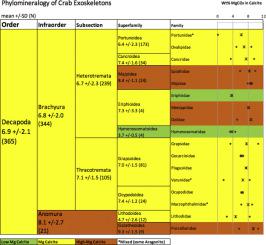Palaeogeography, Palaeoclimatology, Palaeoecology ( IF 2.6 ) Pub Date : 2021-01-10 , DOI: 10.1016/j.palaeo.2021.110219 Ashleigh M. Fay , Abigail M. Smith

|
Skeletal carbonate mineralogy data from the literature was combined with new X-ray diffractometry data from New Zealand crabs, in order to elucidate mineralogical patterns related to body part, habitat, latitude, and phylogeny, with a view to understanding both the potential vulnerability and the preservation potential of crab shells. In general, crab carbonate is 100% Mg-calcite. In nine specimens from three New Zealand species (Austrohelice crassa, Charybdis japonica, and Hemigrapsus crenulatus) we found the first record of aragonite in brachyurid crab carbonate. Brachyurid crabs tested here generally produce Mg-calcite with mean of 6–7 wt% MgCO3, though families Epaltidae, Majidae, Menippidae and Oziidae produ\ce high-Mg calcite (8–9 wt% MgCO3), while Eiphiidae and Hymenosomatidae produce low-Mg calcite (3–4 wt% MgCO3). Anomurid crabs showed no aragonite in any specimen, but varied more in Mg content, with the family Porcellanidae producing the highest mean Mg content found (9.3 wt%MgCO3). In most cases the standard deviation and range of values within species is small (SD 0–1.5, range 1–3 wt% MgCO3. There is little evidence of partitioning of Mg in skeletal elements; Mg in the claw, for example, is not significantly different than that of the carapace, legs, or abdomen, whether considered across all species, or within individuals. Latitude (as a proxy for water temperature), too, does not appear to affect Mg in crabs, though it is possible that environment (rocky vs sandy shore) does. The strong tendency for crabs to produce mid-range Mg in calcite suggests that they may be striking a balance between mechanical strengthening of calcite while limiting solubility in sea water.
中文翻译:

紧要关头:螃蟹的骨骼碳酸盐矿物学(节肢动物:甲壳纲:十足目)
为了阐明与身体部位,生境,纬度和系统发育有关的矿物学模式,将文献中的骨架碳酸盐矿物学数据与来自新西兰螃蟹的新的X射线衍射数据结合起来,以期了解潜在的脆弱性和蟹壳的保存潜力。通常,碳酸螃蟹为100%Mg方解石。在来自三个新西兰物种(Austrohelice crassa,Charybdis japonica和Hemigrapsus crenulatus)的九个标本中,我们发现了腕曲蟹碳酸盐中文石的第一个记录。在这里测试的速生蟹通常产生的方解石镁含量平均为6–7 wt%MgCO 3,尽管Ep科,Ma科、,科和O科生产高镁方解石(8-9 wt%MgCO 3),而E科和and科则产生低镁方解石(3-4 wt%MgCO 3)。奇异蟹在任何标本中均未显示文石,但镁含量变化更大,波氏cell科的平均镁含量最高(9.3 wt%MgCO 3)。在大多数情况下,物种内的标准偏差和值范围很小(SD 0–1.5,范围1-3 wt%MgCO 3。几乎没有证据表明镁在骨骼元素中的分布。例如,无论是在所有物种中还是在个体内部,爪中的镁与甲壳,腿或腹部的镁均无显着差异。纬度(作为水温的替代指标)似乎也不会影响螃蟹中的Mg,尽管环境(岩石与沙质海岸)可能会影响。螃蟹在方解石中产生中等范围的Mg的强烈趋势表明,它们可能在方解石的机械强化与限制在海水中的溶解度之间取得平衡。











































 京公网安备 11010802027423号
京公网安备 11010802027423号